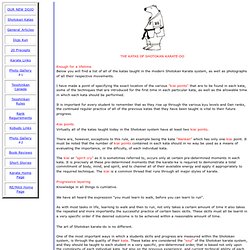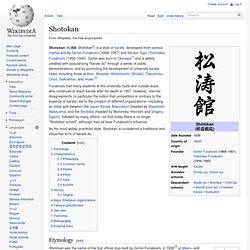

Kata kiai points : Enough for a lifetime Below you will find a list of all of the katas taught in the modern Shotokan Karate system, as well as photographs of all their respective movements.

I have made a point of specifying the exact location of the various "kiai points" that are to be found in each kata, some of the techniques that are introduced for the first time in each particular kata, as well as the allowable time in which each kata should be performed. It is important for every student to remember that as they rise up through the various kyu levels and Dan ranks, the continued regular practice of all of the previous katas that they have been taught is vital to their future progress. Kiai points Virtually all of the katas taught today in the Shotokan system have at least two kiai points. There are, however, exceptions to this rule, an example being the kata "Wankan" which has only one kiai point. Remember: Learning the pattern of all twenty-six katas found in the Shotokan system is one thing, How to learn karate. Learning karate like a new language When you learn Karate, you are first introduced to individual techniques, such as single blocks and strikes.

If we compare learning Karate to learning a new language, you can think of these like the letters of the alphabet. Several techniques strung together may form words. The practice of basic techniques is often simply called “basics”, or Kihon in Japanese. To stay with this analogy, sentences are thus formed by stringing several basic techniques together, for example, in Kihon Ido , which means, “moving basics”, because you step and thus move your body while you block and/or strike.
Typical for Karate are Katas . In this Karate online tutorial, we will follow this approach. Karate Terminology: The Japanese names for the techniques shown vary slightly between different Karate styles. Section 1: Blocks (Uke) Destroying your attacker’s weapons Close-handed Blocks Open-Handed Blocks Wrist Blocks Section 2: Basic Punches and Strikes Section 3: Kicking.
! Martial Arts Supplies, Online Martial Art suppliers of Weapons Equipment punch bags MMA Information Supplier West Midlands UK. Shotokan. Shotokan (松濤館, Shōtōkan?)

Is a style of karate, developed from various martial arts by Gichin Funakoshi (1868–1957) and his son Gigo (Yoshitaka) Funakoshi (1906–1945). Gichin was born in Okinawa[1] and is widely credited with popularizing "karate do" through a series of public demonstrations, and by promoting the development of university karate clubs, including those at Keio, Waseda, Hitotsubashi (Shodai), Takushoku, Chuo, Gakushuin, and Hosei.[2] Funakoshi had many students at the university clubs and outside dojos, who continued to teach karate after his death in 1957. As the most widely practiced style, Shotokan is considered a traditional and influential form of karate do. Etymology[edit] Calligraphy of Shotokan Shotokan was the name of the first official dojo built by Gichin Funakoshi, in 1936[3] at Mejiro, and destroyed in 1945 as a result of an allied bombing.[4] Shoto (松濤, Shōtō?)
Characteristics[edit] Philosophy[edit] Common terms[edit] Ranks[edit] Shotokan Karate Belts Grading, full Syllabus and grade guide. Shotokan Karate. What is Shotokan Karate? Shotokan Karate is one of the most popular Martial Arts practised today. It has its root in the ancient Chinese Martial Arts and, in common with many Martial Arts, can be traced back to the early activities of monks at the Shoalin Temple. Although its early roots are Chinese, Shotokan was originally developed in Okinawa (a small island between China and Japan) and from there spread to Japan (where it was named) and has since spread to the world at large. Shotokan differs in style from other martial arts like Aikido and Tai Chi Chuan that emphasise soft, circular movements.
In contrast Shotokan emphasises linear rather than circular movements and its "Hard" style can be aggressive and devastating to an opponent. Whilst Shotokan can be practised by people of all ages and abilities, like many other things in life, it is not for everyone. The History of Shotokan As there is no written history of the origins of Martial Arts , we must rely on word of mouth and legend.